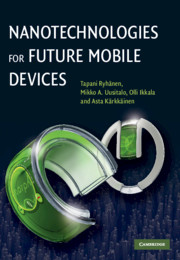Book contents
- Frontmatter
- Contents
- List of contributors
- Preface
- 1 When everything is connected
- 2 On the possible developments for the structural materials relevant for future mobile devices
- 3 Energy and power
- 4 Computing and information storage solutions
- 5 Sensing, actuation, and interaction
- 6 Future of Radio and Communication
- 7 Flat panel displays
- 8 Manufacturing and open innovation
- 9 Seeing beyond the hype: what the Internet teaches us about the development of nanotechnology
- 10 Conclusions
- Index
- References
5 - Sensing, actuation, and interaction
Published online by Cambridge University Press: 05 July 2014
- Frontmatter
- Contents
- List of contributors
- Preface
- 1 When everything is connected
- 2 On the possible developments for the structural materials relevant for future mobile devices
- 3 Energy and power
- 4 Computing and information storage solutions
- 5 Sensing, actuation, and interaction
- 6 Future of Radio and Communication
- 7 Flat panel displays
- 8 Manufacturing and open innovation
- 9 Seeing beyond the hype: what the Internet teaches us about the development of nanotechnology
- 10 Conclusions
- Index
- References
Summary
Introduction
Ubiquitous sensing, actuation, and interaction
The London of 2020, as described in Chapter 1, will have conserved most of its old character but it will also have become a mixed reality built upon the connections between the ubiquitous Internet and the physical world. These connections will be made by a variety of different intelligent embedded devices. Networks of distributed sensors and actuators together with their computing and communication capabilities will have spread throughout the infrastructures of cities and to various smaller objects in the everyday environment. Mobile devices will connect their users to this local sensory information and these smart environments. In this context, the mobile device will be a gateway connecting the local physical environment of its user to the specific digital services of interest, creating an experience of mixed virtual and physical realities. (See also Figure 1.1.)
Human interaction with this mixed reality will be based on various devices that make the immediate environment sensitive and responsive to the person in contact with it. Intelligence will become distributed across this heterogeneous network of devices that vary from passive radio frequency identification (RFID) tags to powerful computers and mobile devices. In addition, this device network will be capable of sharing information that is both measured by and stored in it, and of processing and evaluating the information on various levels.
Information
- Type
- Chapter
- Information
- Nanotechnologies for Future Mobile Devices , pp. 121 - 173Publisher: Cambridge University PressPrint publication year: 2010
